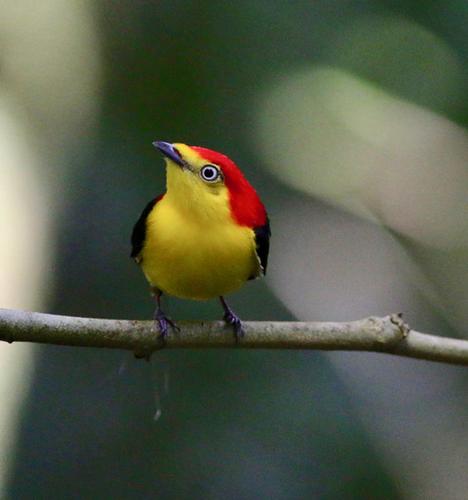当前位置:
X-MOL 学术
›
Funct. Ecol.
›
论文详情
Our official English website, www.x-mol.net, welcomes your feedback! (Note: you will need to create a separate account there.)
Longitudinal dynamics and behavioural correlates of telomeres in male wire‐tailed manakins
Functional Ecology ( IF 5.2 ) Pub Date : 2020-11-21 , DOI: 10.1111/1365-2435.13715 Ben J. Vernasco 1 , Roslyn Dakin 2 , Ariana D. Majer 3 , Mark F. Haussmann 3 , T. Brandt Ryder 2 , Ignacio T. Moore 1
中文翻译:

雄性金属尾马胶中端粒的纵向动力学和行为相关性
更新日期:2020-11-21
Functional Ecology ( IF 5.2 ) Pub Date : 2020-11-21 , DOI: 10.1111/1365-2435.13715 Ben J. Vernasco 1 , Roslyn Dakin 2 , Ariana D. Majer 3 , Mark F. Haussmann 3 , T. Brandt Ryder 2 , Ignacio T. Moore 1
Affiliation

|
- Building on the predictions of state‐dependent life‐history theory, telomeres are hypothesized to either correlate with or function as an adaptive, proximate mediator of an individual's behaviour and life‐history strategy. To further understand the relationship between telomeres, behaviour and life‐history strategies, we measured male behaviour, telomere lengths and telomere dynamics in a free‐living population of known‐age, male wire‐tailed manakins Pipra filicauda.
- Male wire‐tailed manakins perform coordinated displays with other males at leks and these displays form the basis of long‐term coalition partnerships. Males exhibit consistent individual differences in the number of social partners within their social network and the frequency of social interactions. Male sociality is also positively correlated with both social rise and reproductive success.
- We measured male behaviour using a telemetry‐based, proximity datalogging system and blood telomere lengths were quantified using qPCR. We examined the relationships between telomere length, telomere dynamics, social status, and male behaviour. We also quantified the repeatability of telomere lengths, examined age‐related changes in telomere length, and tested for instances of telomere elongation that exceed residual error in telomere length.
- Telomere length was found to be highly repeatable. More social males exhibited shorter telomeres and higher rates of telomere attrition. Telomeres did not significantly vary with age within or between individuals in either of the male social classes. Two out of 25 individuals exhibited patterns telomere elongation that exceeded residual error in telomere measurements.
- Here we show that telomeres consistently vary between male wire‐tailed manakins and these differences are related to variation in male social behaviour. In this relatively long‐lived species, telomeres appear to be flexible traits that can increase or decrease in length. Overall, this study provides observational support for the hypothesis that telomeres act as a molecular marker that relates to behaviour in a state‐dependent manner. We also provide insight into the molecular consequences of individual variation in male social behaviour.
中文翻译:

雄性金属尾马胶中端粒的纵向动力学和行为相关性
- 在状态依赖型生活史理论的预测基础上,假设端粒与个人行为和生活史策略的适应性,邻近性调解人相关或起着调适作用。为了进一步了解端粒,行为与生活史策略之间的关系,我们测量了已知年龄的雄性金属尾山柑(Pipra filicauda)的自由生活种群中的男性行为,端粒长度和端粒动力学。
- 雄性铁尾山雀鱼与其他雄性鱼在鳞茎上进行协调的展示,这些展示构成了长期联盟伙伴关系的基础。男性在其社交网络中社交伙伴的数量和社交互动的频率上表现出一致的个体差异。男性社交也与社会兴起和生殖成功呈正相关。
- 我们使用基于遥测的接近数据记录系统测量了男性行为,并使用qPCR定量了血端粒长度。我们研究了端粒长度,端粒动力学,社会地位和男性行为之间的关系。我们还量化了端粒长度的可重复性,检查了与年龄相关的端粒长度变化,并测试了端粒伸长超过端粒长度残留误差的情况。
- 发现端粒长度是高度可重复的。社交男性较多,端粒较短,端粒磨损率较高。在男性社会阶层中的任何一个人内部或之间,端粒没有显着变化。25个人中有2个人的端粒伸长率模式超过了端粒测量中的残留误差。
- 在这里,我们表明,端粒端粒在雄性马尾型manakins之间始终存在差异,这些差异与雄性社会行为的变异有关。在这种相对长寿的物种中,端粒似乎是可以增加或减少长度的灵活性状。总体而言,本研究为端粒充当与状态相关的行为相关的分子标记的假说提供了观察依据。我们还提供了有关男性社会行为中个体差异的分子后果的见解。



























 京公网安备 11010802027423号
京公网安备 11010802027423号